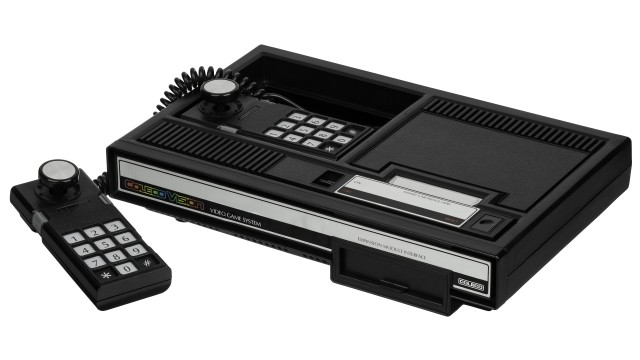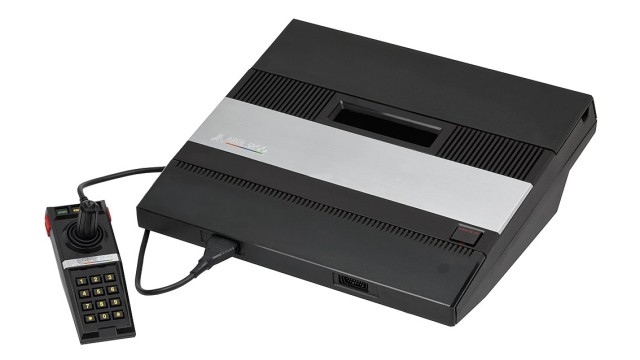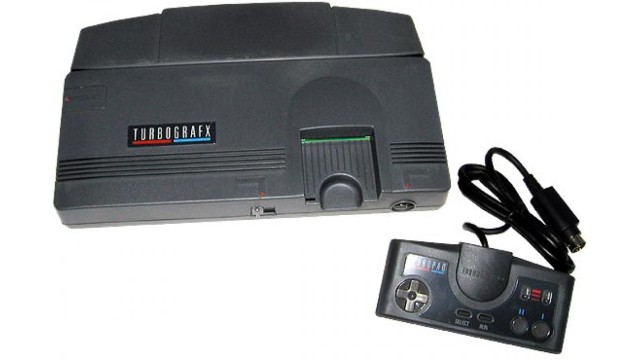
Master System
 Manufacturer: Sega
Manufacturer: SegaLaunches: 1985
Discontinued: 1996
Life span: 11 years
Units sold: 13 000 000
Generation: 3rd
Country releases of Master System
 Japan: Japan: | Oct/1985 | ||
 Germany: Germany: | Oct/1986 | ||
 Spain: Spain: | 01/Dec/1987 | ||
 Brazil: Brazil: | 04/Nov/1989 |
 Master System technical specifications
Master System technical specifications
CPU: Zilog Z80
Memory: 8 KB
 Master System video specifications
Master System video specifications
Master System graphics capabilities.
Video chip: Texas Instruments TMS9918
Video connection:
Master System video modes
| 256×192 | 32 colors |
 Master System audio specifications
Master System audio specifications
Master System sound capabilities.
Audio chip: Texas Instruments SN76489 (Yamaha YM2413 in JP)
Audio mode:
 Controllers of Master System
Controllers of Master System
 Master System games support
Master System games support
Support:
Master System games
Games library:
Master System story
The Sega Master System was a pivotal console in the history of video gaming, representing Sega’s first major effort to establish itself in the home console market. Its creation, development, launch, and subsequent market reception all reflect the challenges and opportunities faced by Sega as it sought to compete with the dominant forces in the gaming industry during the mid-1980s. The story of the Sega Master System is one of ambition, innovation, and fierce competition, particularly with Nintendo, which had already begun to establish a significant foothold in the market.
The creation of the Sega Master System was driven by Sega’s desire to diversify its product offerings and break into the rapidly growing home console market. During the early 1980s, Sega was primarily known as an arcade game company. It had developed a number of successful arcade titles, and this success in the arcade sector gave Sega the confidence to explore the home gaming market. Sega initially entered the home console market with the SG-1000 in 1983, which was released in Japan on the same day as Nintendo’s Famicom. The SG-1000 was a modest system, offering basic gaming capabilities, but it did not achieve significant commercial success, particularly when compared to the Famicom, which quickly gained popularity. Recognizing the need for a more powerful system to compete with Nintendo, Sega began work on a new console that would offer superior graphics and sound.
The development of the Sega Master System began in 1984, led by a team of engineers and designers at Sega’s headquarters in Japan. The goal was to create a console that could surpass the technical capabilities of the Famicom, which had become the industry standard. Sega decided to base the new console on its successful arcade hardware, leveraging its experience in creating powerful and visually impressive arcade games. The system was designed around an 8-bit Zilog Z80A processor, which was faster than the processor used in the Famicom. This choice allowed the Master System to handle more complex graphics and smoother gameplay.
In addition to its powerful processor, the Sega Master System featured advanced graphics and sound capabilities for its time. The system’s graphics chip could display up to 32 colors simultaneously from a palette of 64, which was a significant improvement over the Famicom’s more limited color palette. This allowed for more detailed and vibrant visuals in games, giving the Master System an edge in terms of graphical fidelity. The console also included a Texas Instruments SN76489 sound chip, which provided better audio quality than the Famicom’s sound hardware. These technical advantages were central to Sega’s strategy of positioning the Master System as a superior alternative to Nintendo’s console.
The physical design of the Sega Master System was also a key aspect of its development. Sega wanted to create a console that was not only powerful but also visually appealing and easy to use. The system featured a sleek, angular design with a black and red color scheme that was distinctly different from the more utilitarian design of the Famicom. The Master System’s controllers were designed to be comfortable and responsive, with a layout that included a directional pad and two action buttons. Sega also developed a unique pause button on the console itself, rather than on the controller, which was an unusual design choice but one that set the system apart from its competitors.
The launch of the Sega Master System marked Sega’s serious entry into the global home console market. The console was first released in Japan in October 1985 under the name Sega Mark III, an evolution of the earlier SG-1000 series. In Japan, however, the Mark III faced stiff competition from the Famicom, which by this time had established a strong market presence. Despite its technical superiority, the Mark III struggled to gain traction in Japan, where Nintendo’s dominance was firmly established, and the company’s strong relationships with third-party developers ensured a steady stream of high-quality games for the Famicom.
Realizing that success in Japan alone would be difficult to achieve, Sega turned its attention to the international market, particularly North America and Europe. In June 1986, Sega rebranded the Mark III as the Sega Master System and launched it in North America. The console was distributed by Tonka, a toy company, which was an unconventional choice but one that Sega hoped would help the Master System reach a broader audience. The North American launch was accompanied by an aggressive marketing campaign that highlighted the system’s superior graphics and sound, positioning it as the “most advanced video game system” available.
The Master System’s European launch took place in 1987, and it was here that the console found its greatest success. Unlike in Japan and North America, where Nintendo had a strong foothold, the European market was more fragmented, with no single console dominating the scene. This allowed the Master System to gain a significant market share, particularly in countries like the United Kingdom, France, and Brazil. In Brazil, the Master System became particularly popular, eventually becoming one of the best-selling consoles of all time in the region, thanks to a long partnership between Sega and the local company Tectoy.
The market reception of the Sega Master System varied significantly by region. In Japan, the console was overshadowed by the Famicom and failed to achieve substantial market penetration. Nintendo’s stronghold on the Japanese market, coupled with its extensive library of popular games, made it difficult for the Master System to compete. As a result, Sega shifted its focus away from Japan and towards international markets where it believed the console could have a greater impact.
In North America, the Sega Master System faced significant challenges due to the overwhelming popularity of the Nintendo Entertainment System (NES). Nintendo’s aggressive business practices, including its strict control over third-party developers and its marketing dominance, made it difficult for the Master System to gain a foothold. Nintendo’s licensing agreements effectively barred many third-party developers from creating games for the Master System, which limited the console’s game library. Despite Sega’s efforts to promote the Master System as a technologically superior alternative to the NES, it struggled to compete with Nintendo’s extensive library of popular games, including titles like Super Mario Bros. and The Legend of Zelda.
However, in Europe and Brazil, the Master System was much more successful. In Europe, the Master System’s superior graphics and sound, combined with a more open market, allowed it to compete effectively with the NES. The console developed a strong following in countries like the United Kingdom, France, and Spain, where it enjoyed considerable commercial success. In Brazil, the Master System’s success was even more pronounced, as the console became a cultural phenomenon. Tectoy’s localization efforts, including the translation of games into Portuguese and the development of exclusive titles, helped the Master System become the dominant console in the region, a position it maintained for many years.
The Master System’s library of games was one of its key strengths, particularly in the regions where it was most successful. While it struggled to attract third-party developers due to Nintendo’s dominance, Sega developed a strong lineup of first-party titles that showcased the console’s capabilities. Games like Alex Kidd in Miracle World, which was the system’s mascot title before the rise of Sonic the Hedgehog, Phantasy Star, an early and influential RPG, and Shinobi, an arcade-style action game, helped to define the Master System’s identity. These games demonstrated the system’s graphical prowess and offered engaging gameplay experiences that were distinct from what was available on the NES.
Despite its successes, the Sega Master System ultimately could not unseat Nintendo as the leader in the global console market. The NES’s overwhelming dominance in North America and Japan, coupled with its extensive library of games, made it difficult for the Master System to achieve widespread success outside of its strongholds in Europe and Brazil. However, the Master System laid the groundwork for Sega’s future in the console market, particularly with the launch of the Sega Genesis (Mega Drive) in 1988, which would go on to become Sega’s most successful console and a true competitor to Nintendo’s dominance.
The legacy of the Sega Master System is significant, as it represents Sega’s first serious attempt to challenge Nintendo in the home console market. The system’s advanced hardware, innovative design, and strong library of games helped to establish Sega as a major player in the gaming industry. The Master System also played a crucial role in the development of Sega’s future consoles, particularly the Genesis, which would build on the technical foundation laid by the Master System. While it never achieved the same level of success as the NES, the Sega Master System remains an important part of gaming history, particularly in regions where it enjoyed strong commercial success.
Next Sega console: Mega Drive




